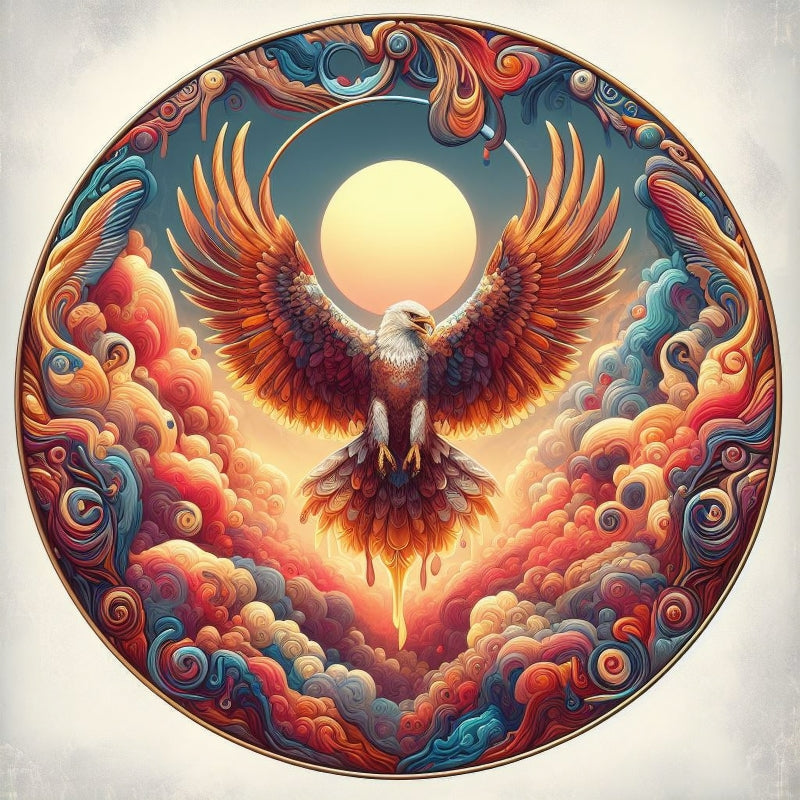
What Eagle Symbolizes in Different Cultures
Share
Eagles have long captivated human imagination with their majestic presence, powerful flight, and keen eyesight. As apex predators, they embody strength, freedom, and resilience. Across various cultures and civilizations, eagles have been revered as symbols of power, spirituality, and connection to the divine. This blog post explores the diverse meanings and representations of eagles in different cultures around the world, drawing on scholarly articles and authoritative sources.
1. Eagle Symbolism in Ancient Egypt
In ancient Egyptian culture, the eagle was associated with the goddess Nekhbet, who represented protection and motherhood. Depicted as a vulture or an eagle, she was believed to safeguard the pharaohs and their reign. Eagles were often shown in hieroglyphs and art, symbolizing strength and divine authority. The royal standard of pharaohs frequently featured the eagle, signifying their divine right to rule over Egypt. The eagle's ability to soar high above the earth made it a fitting emblem for leaders who were believed to be chosen by the gods.
2. Greek Mythology and the Eagle
In Greek mythology, eagles held significant importance as symbols of Zeus, the king of the gods. According to myth, Zeus transformed into an eagle to abduct Europa, a beautiful princess from Crete. The eagle was also associated with Athena, the goddess of wisdom and warfare, often depicted with an eagle on her shield or helmet. The Greeks viewed eagles as symbols of courage and intelligence, representing the ideals of heroism and nobility.
3. Norse Mythology
In Norse mythology, eagles were seen as powerful creatures associated with gods like Odin. The golden eagle was considered sacred to Odin, who was known as the god of war and wisdom. Eagles were believed to be messengers between the gods and humans, carrying prayers to the heavens. The cry of an eagle was thought to signify the birth of a heroic soul, further enhancing its status as a symbol of valor and nobility.
4. Hinduism: Garuda
In Hindu mythology, the eagle is represented by Garuda, a divine bird that serves as the mount of Lord Vishnu. Garuda is depicted with a human body and wings of an eagle, symbolizing strength and speed. He is revered as a protector against evil forces and is often associated with knowledge and enlightenment. Garuda's significance extends beyond mythology; he is also considered a symbol of cosmic order maintained by the gods.
5. Native American Culture
Eagles hold profound significance in Native American cultures across North America. They are viewed as sacred beings representing strength, courage, and wisdom. Many tribes believe that eagles serve as spiritual messengers between humans and the Creator. For instance:
- Hopi Tribe: In Hopi culture, eagles symbolize a connection between the physical world and the spirit world.
- Navajo Tribe: The Navajo consider eagles as symbols of healing and renewal.
- Lakota Tribe: Eagle feathers are highly revered in Lakota traditions; they represent honor and bravery. A warrior who displayed exceptional courage would receive an eagle feather as recognition.
The use of eagle feathers in spiritual ceremonies underscores their importance in Native American culture; they are considered gifts from the sky that carry prayers to the Creator.
6. Christianity
In Christianity, eagles symbolize hope, renewal, and divine protection. The Bible references eagles multiple times; one notable passage is Isaiah 40:31: “But those who hope in the Lord will renew their strength; they will soar on wings like eagles.” This metaphorical use emphasizes resilience and faith in divine guidance during challenging times.Eagles are also depicted in Christian art as symbols of salvation and resurrection due to their ability to soar high above earthly troubles.
7. Islamic Symbolism
In Islamic culture, eagles represent nobility, power, and ferocity in battle. They are often associated with warriors due to their hunting prowess and keen eyesight. The eagle's ability to soar high symbolizes spiritual elevation and connection to God.In some Islamic traditions, eagles are considered sacred animals that embody qualities such as bravery and dominance over adversaries.
8. Aztec Culture
In Aztec mythology, eagles were revered as symbols of power and divinity. The Aztecs believed that their chief god instructed them to settle where they found an eagle perched on a cactus devouring a snake—this location became Mexico City. The eagle's image was prominently featured on their national emblem, representing strength and resilience.
9. Celtic Symbolism
In Celtic culture, eagles were seen as messengers between worlds—earthly realms and spiritual dimensions. They were associated with wisdom and foresight due to their ability to fly at great heights while observing everything below them.Celtic warriors often adopted eagle motifs in their armor or tattoos as symbols of bravery during battles.
10. Modern Symbolism
In contemporary society, eagles continue to serve as powerful symbols for various nations:
- United States: The bald eagle is a national symbol representing freedom and independence.
- Mexico: The golden eagle appears on the national flag alongside a serpent on a cactus.
- Germany: The federal eagle represents sovereignty in German heraldry.
These modern representations highlight how deeply ingrained eagle symbolism is within national identities worldwide.
Conclusion
Eagles have transcended cultural boundaries through history; their symbolism varies across civilizations yet consistently embodies themes of strength, freedom, wisdom, and spirituality. From ancient mythologies to modern national emblems, these majestic birds continue to inspire awe among people around the globe. Understanding what eagles symbolize in different cultures enriches our appreciation for these magnificent creatures while reminding us of humanity's enduring connection with nature's wonders. As we strive for conservation efforts aimed at protecting these apex predators from threats like habitat loss or poaching—let us also honor their cultural significance by preserving not only their physical existence but also our shared heritage intertwined with them.
Through this exploration into various cultural interpretations surrounding eagles' symbolism—one thing remains clear: they will forever soar high above us—both literally & metaphorically—reminding us all that we too can rise above challenges if we embrace our inner strength & wisdom just like these magnificent birds do every day!
Citations:
[1] https://www.freedomgpt.com/wiki/symbolism-of-the-eagle
[2] http://www.pure-spirit.com/more-animal-symbolism/629-eagle-symbolism
[3] http://www.crystalinks.com/Eagle.html
[4] https://eagles.org/what-we-do/educate/learn-about-eagles/golden-eagle-as-a-national-symbol/
